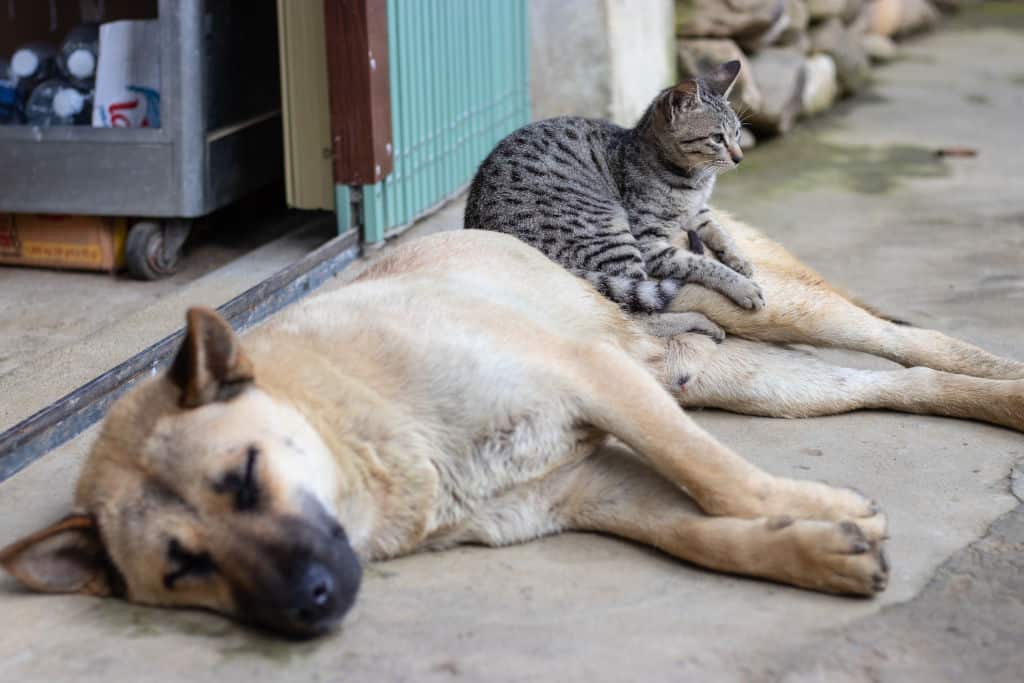Dogs will be dogs, and some have a strong prey drive that is difficult to control. A stray cat was in their field of vision, and your dog attacked and killed it. So what to do now?
The best thing you can do is to contact Animal Control to scan the cat for a microchip, as it could have belonged to someone. In addition, get your dog checked at the vet immediately, and look into training your dog to control their prey drive.
This article explores why dogs attack stray cats, what to do when it happens, and whether you can train your dog not to attack cats in the future.

Do Dogs Often Attack and Kill Stray Cats?
Dogs are natural predators. Even if we try to give dogs human characteristics, they are still dogs and can be vicious.
My dog nearly killed a cat. He is a beautiful pet who is well-trained and friendly. He does, however, have the instinct to hunt and kill. Fortunately, I arrived quickly and stopped him from further injuring the cat.
It’s just a hardwired survival instinct in their brain. It’s in their blood. This is one of the reasons why you shouldn’t let your cats outside – the neighbor’s dog could kill them. Dogs can have strong prey drives. If your dog killed a stray cat, they were most likely acting instinctively.
If the cat was on their property, they might have the instinct to kill it. They will also chase the cat on the street if they are not trained to resist this urge.
However, one isolated incident of a dog killing a stray cat doesn’t necessarily indicate a pattern. Much like humans, dogs’ behavior can vary based on the situation and triggering factors.
Can You Face Legal Consequences if Your Dog Kills a Cat?
The general rule is that you are safe if your dog was leashed and the other animal was not. You should be fine if it happened on your property, regardless of whether the cat had an owner. In some cases, though, they may have the right to file a civil claim against you.
Some areas have codified cat roaming rights, so check your local laws, but otherwise, if your dog kills someone’s cat in your yard, the cat owner has no legal recourse.
If the cat was a stray, be assured that such things unfortunately happen. It’s in a dog’s nature to chase small animals, and they can be brutal. Legally, whether it was on your property or not, you should be fine, but have the cat scanned for a microchip just in case.
Even if the cat belonged to someone, the cat owner accepts the risk of something similar happening when they allow their cat to roam the neighborhood. While it’s probably a stray cat roaming around, it’s best to check the local laws on free-roaming cats.
I adore cats, but allowing them to roam freely outside in urban areas is irresponsible and leads to their death. Unfortunately, some cat owners have to learn the hard way.
However, if your dog killed a cat, someone may be distraught over the loss of this cat, and you should inform them. The cat owner is still responsible for keeping their pet safe and contained on their property.

Do You Need to Put Your Dog Down for Killing a Cat?
You don’t have to put your dog down for killing a cat, whether it happened on your property or someone else’s. It is entirely up to you to decide what to do with the dog. However, euthanizing a dog for acting on his prey drive is inhumane.
There’s no reason to believe you’d have to put your dog down because of this. Your dog was simply acting like a dog. It doesn’t mean he is cruel, vicious, or a bad dog. Some dogs have a strong desire to hunt, and your dog is not a “bad” dog because he is acting predatory.
In most cases, hunting behavior does not translate into aggression. A dog can be both a manic cat killer and a friendly companion.
My GSD mix has a strong prey drive, and anything small and furry that moves quickly catches his attention. I would never leave him alone with the cats, but I would never euthanize him for following his animal instincts.
A dog acts instinctively. They cannot be held responsible for the mechanism that will ensure their survival. However, as a dog owner, you must keep your dog leashed if you can’t control them. Otherwise, you should be prepared to face the consequences of such incidents.
How to Deal With Your Dog After the Incident?
If your dog killed a cat, the only thing you can do now is to take the cat’s remains to a vet or shelter to be scanned for a microchip. It could be a stray or someone’s outdoor cat. It is proper to notify the owner if it belongs to them.
If it was someone else’s cat, always inform them because nothing is worse than not knowing what happened to your pet. Leave out the gory details and state that the cat did not suffer. They should know if their cat is missing.
Remember to take your dog to the vet. Cat scratches and bites are extremely dangerous in terms of infection.
Ideally, your dog should not be around cats, but you cannot control the pets or strays that come onto your property. You can only quickly inspect your yard before letting him out, and consider training your dog.

Can You Train Your Dog Not to Attack Stray Cats?
Training your dog is always a good idea, and it’s never too late. Basic commands such as “leave it,” “drop it,” and training recall may be helpful if a similar situation arises again.
Prey drive is a significant barrier in training dogs not to chase small animals.
You will never be able to eliminate prey drive completely, nor should you try, but you can teach a dog to control their impulses. Although the prey drive is always present, they can be taught not to act on it.
Territorial behavior can also be improved through training. I recommend involving a professional in this. Be careful, because there are bad and good ways to choose a trainer. Here’s a good way.
A great way to avoid these incidents is to keep the strays out of your yard. You can buy coyotes or other animal urine to scare the cats away from the yard and retouch it until the cat has left.
Cat-proofing your yard is a far better way to ensure your dog never kills a stray cat by running out of the property. Determine how the cat enters and either block the entrance or use scents to deter the cat. Otherwise, capture the stray animals and transport them to animal control.
It is critical to socialize dogs with other animals at a young age if you want to control your dog around people and other animals. The ideal age for socializing a puppy is between 3 and 12 weeks, as this will make them happier and calmer around cats. In fact, early exposure to cats might lower the probability of future aggression.
Finally, many dogs simply cannot be trusted in the presence of other animals, including cats, so keep them leashed at all times.
FAQs
Why do dogs often attack cats?
Some dogs have prey drives, which could explain why this happened. If the cat was on their property, they might have felt compelled to attack it. They will also chase the cat on the street if they are not trained to resist this urge.
Do dogs understand when they kill a cat?
While they may have a high prey drive, they may be unable to stop themselves before their prey dies. You can see this behavior when they shake their toys. Once the cat is dead, they probably understand, but what’s done is done.
Which dog breeds are known for NOT killing cats?
Typically, dogs that do not attack cats have a lower prey drive. Larger dogs include the Golden Retriever, Bernese Mountain Dog, and Newfoundland. Smaller dogs include the Pekinese, King Charles Cavalier Spaniel, and Shih Tzu.
If you want to get a dog, your best bet is to find one that has already been tested around cats and isn’t interested in them. Getting a dog who has grown up with cats and thus sees them as a family member is the best factor for preventing cat attacks.
Alex, a passionate animal lover, has experience in training and understanding animal behavior. As a proud pet parent to two dogs and three cats, he founded AnimalReport.net to share insights from animal experts and expand his knowledge of the animal kingdom.




